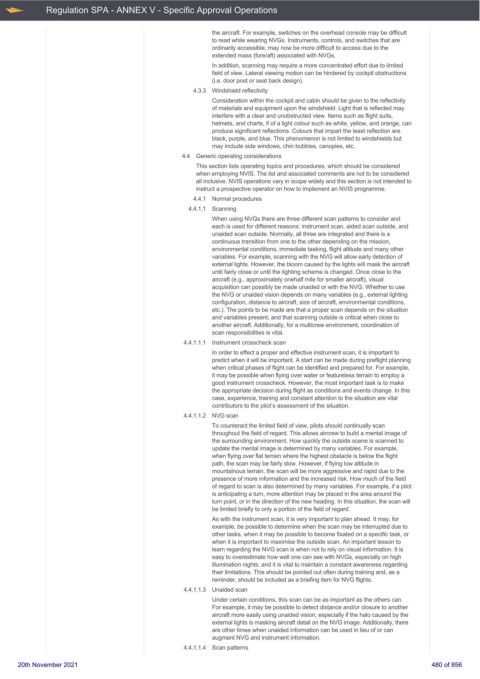Page 480 - UK Air Operations Regulations (Consolidated) 201121
P. 480
~
~ Regulation SPA - ANNEX V - Specific Approval Operations Centrik
the aircraft. For example, switches on the overhead console may be difficult
to read while wearing NVGs. Instruments, controls, and switches that are
ordinarily accessible, may now be more difficult to access due to the
extended mass (fore/aft) associated with NVGs.
In addition, scanning may require a more concentrated effort due to limited
field of view. Lateral viewing motion can be hindered by cockpit obstructions
(i.e. door post or seat back design).
4.3.3 Windshield reflectivity
Consideration within the cockpit and cabin should be given to the reflectivity
of materials and equipment upon the windshield. Light that is reflected may
interfere with a clear and unobstructed view. Items such as flight suits,
helmets, and charts, if of a light colour such as white, yellow, and orange, can
produce significant reflections. Colours that impart the least reflection are
black, purple, and blue. This phenomenon is not limited to windshields but
may include side windows, chin bubbles, canopies, etc.
4.4 Generic operating considerations
This section lists operating topics and procedures, which should be considered
when employing NVIS. The list and associated comments are not to be considered
all inclusive. NVIS operations vary in scope widely and this section is not intended to
instruct a prospective operator on how to implement an NVIS programme.
4.4.1 Normal procedures
4.4.1.1 Scanning
When using NVGs there are three different scan patterns to consider and
each is used for different reasons: instrument scan, aided scan outside, and
unaided scan outside. Normally, all three are integrated and there is a
continuous transition from one to the other depending on the mission,
environmental conditions, immediate tasking, flight altitude and many other
variables. For example, scanning with the NVG will allow early detection of
external lights. However, the bloom caused by the lights will mask the aircraft
until fairly close or until the lighting scheme is changed. Once close to the
aircraft (e.g., approximately onehalf mile for smaller aircraft), visual
acquisition can possibly be made unaided or with the NVG. Whether to use
the NVG or unaided vision depends on many variables (e.g., external lighting
configuration, distance to aircraft, size of aircraft, environmental conditions,
etc.). The points to be made are that a proper scan depends on the situation
and variables present, and that scanning outside is critical when close to
another aircraft. Additionally, for a multicrew environment, coordination of
scan responsibilities is vital.
4.4.1.1.1 Instrument crosscheck scan
In order to effect a proper and effective instrument scan, it is important to
predict when it will be important. A start can be made during preflight planning
when critical phases of flight can be identified and prepared for. For example,
it may be possible when flying over water or featureless terrain to employ a
good instrument crosscheck. However, the most important task is to make
the appropriate decision during flight as conditions and events change. In this
case, experience, training and constant attention to the situation are vital
contributors to the pilot’s assessment of the situation.
4.4.1.1.2 NVG scan
To counteract the limited field of view, pilots should continually scan
throughout the field of regard. This allows aircrew to build a mental image of
the surrounding environment. How quickly the outside scene is scanned to
update the mental image is determined by many variables. For example,
when flying over flat terrain where the highest obstacle is below the flight
path, the scan may be fairly slow. However, if flying low altitude in
mountainous terrain, the scan will be more aggressive and rapid due to the
presence of more information and the increased risk. How much of the field
of regard to scan is also determined by many variables. For example, if a pilot
is anticipating a turn, more attention may be placed in the area around the
turn point, or in the direction of the new heading. In this situation, the scan will
be limited briefly to only a portion of the field of regard.
As with the instrument scan, it is very important to plan ahead. It may, for
example, be possible to determine when the scan may be interrupted due to
other tasks, when it may be possible to become fixated on a specific task, or
when it is important to maximise the outside scan. An important lesson to
learn regarding the NVG scan is when not to rely on visual information. It is
easy to overestimate how well one can see with NVGs, especially on high
illumination nights, and it is vital to maintain a constant awareness regarding
their limitations. This should be pointed out often during training and, as a
reminder, should be included as a briefing item for NVG flights.
4.4.1.1.3 Unaided scan
Under certain conditions, this scan can be as important as the others can.
For example, it may be possible to detect distance and/or closure to another
aircraft more easily using unaided vision, especially if the halo caused by the
external lights is masking aircraft detail on the NVG image. Additionally, there
are other times when unaided information can be used in lieu of or can
augment NVG and instrument information.
4.4.1.1.4 Scan patterns
20th November 2021 480 of 856

